The Air Force has been among the most adaptable elements of the US military over the last decade-plus of war. USAF has perfected the art of joint operations and allowed all the other services to operate without ever having to worry about whether they would get the support they need, said Army Gen. Martin E. Dempsey, Chairman of the Joint Chiefs of Staff, during the Air Force Association’s Air & Space Conference in September.
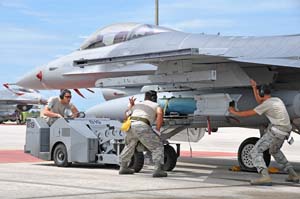 | ||
|
L-r: SrA. Antonio Ortega, MSgt. Nelson Rodriguez, and SrA. Christian Marrero-Santana load a GBU-54 bomb onto an F-16 at Homestead ARB, Fla. The average airman is younger, and the force is more well-educated. (USAF photo by SrA. Jacob Jimenez) |
Today, airmen are operating alongside the Army, Navy, and Marine Corps—moving people and equipment across the globe, leading caravans down dangerous IED-laden roads in Afghanistan, providing overwatch and close air support to troops on the ground, flying spacecraft, and downloading data.
Combatant commanders have come to rely on the Air Force’s dominance of air, space, and cyberspace, but few actually know what is required to achieve the mission. Through all these joint operations, the Air Force has largely opted not to advocate for itself. That has to change, concluded dozens of active and retired senior leaders at the conference held at National Harbor, Md.
During his conference address, Air Force Chief of Staff Gen. Mark A. Welsh III told the story of Army Maj. Gen. James C. Boozer, deputy commanding general of US Army Europe. Boozer, who has commanded at almost every level, including four times during combat, told Welsh that as a commander he worries about everything from ammunition storage points to tactics, logistics, and intelligence, “but not once in my career have I ever worried about anything ‘up there,’ ” said Welsh, quoting Boozer, referring to command of the air.
Boozer also freely admits he has no idea how it happens either, added Welsh.
“He just doesn’t worry about it because it’s never wrong. … That is an incredible testimony. It’s also a little worrisome because he doesn’t know how it happens,” said Welsh. “He has no idea what goes into it. He doesn’t know the resources required. He doesn’t understand how many people are operating to make sure he doesn’t have to worry about what’s up there. I believe my job, our job, is to tell him.”
Because Boozer isn’t alone.
The general consensus at the conference was that it is time for USAF to stop resting on the laurels of airpower and start shouting its accomplishments loudly and proudly. Retired Lt. Gen. David A. Deptula, former deputy chief of staff for intelligence, surveillance, and reconnaissance, said the Air Force has always assumed that airpower speaks for itself. The problem with that theory, said Deptula, is that Washington, D.C., is a “town where people will argue successfully that one plus one equals three and then [base] national policies on that.”
Becoming “Air-Minded”
Deptula argued that “good strategy is developed through competition of ideas, but to have good competition you need good advocacy.”
Retired Maj. Gen. Charles J. Dunlap Jr., former deputy judge advocate general, said airmen need to be more aggressive while defending their service. Too many airmen believe their job ends when they make the ground commander successful. They must become more “air-minded” and not place so many constraints on airpower, he said.
“The other teams are playing rough and they are advocating strongly,” said Dunlap during the same panel discussion with Deptula. “I firmly believe that’s how you get the best. You don’t launch ad hoc attacks. You talk about what you are trying to achieve, which is mission success and wise stewardship of taxpayer resources.”
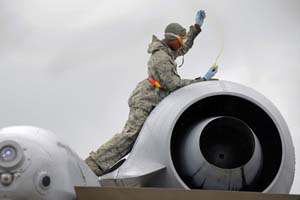 | ||
|
A1C Tevin Duhart checks for debris in an oil sample taken from an A-10 engine at Selfridge ANGB, Mich. (USAF photo by TSgt. David Kujawa) |
The future will continue to be fiscally daunting and the international landscape is becoming increasingly dynamic and uncertain, making cost effectiveness even more vital to mission success, said Air Force Secretary Michael B. Donley.
“As this tension grows, as the uncertainty continues, we need to ensure that we remain well-grounded in the foundations of our Air Force,” said Donley. “The more uncertainty there is, the more budgetary churn ahead, the more important it is to come back to basics—to the Air Force family and the central role of airmen in the fight.”
However, the current environment means the service must take “an honest look in the mirror” and figure out exactly what role it will play in the future American national security spectrum, said Welsh. Then it must fight with all its might to ensure mission success.
“The Air Force matters. It’s important that we tell that story. We’re not better than anybody else, folks, but we’re just as essential,” he continued.
Part of the problem is that the Air Force’s message often gets lost in translation, thanks in large part to a continuously evolving bowl of service alphabet soup that can be difficult for even the most senior Air Force leaders to digest. Welsh acknowledged even he doesn’t understand “what all the terminology means,” saying he is “not understanding the stories” when he hears them. The constant evolution in terminology is causing a disconnect within the Air Force, among its sister services, and with Congress, even though the overall mission has not changed.
Executive Order 9877, part of the 1947 National Security Act—through which the Air Force was born—states that the Defense Department’s newest service would be responsible for achieving and maintaining “air superiority, strategic air forces, air reconnaissance, airlift, air support for ground forces, [and] coordination of air defenses,” said Welsh.
That’s exactly what the Air Force does today.
“We can call [these missions] whatever we want, but this is what [combatant commanders] are looking for. They all understand these words,” said Welsh. “My concern is we’re not telling our own story well enough. We’re trying, but something’s not connecting.”
Dempsey urged the Air Force to “hang onto fundamentals,” acknowledging that stopping the Air Force also would halt the other services from accomplishing their own missions. Without air superiority, said Welsh, the Army and Marine Corps would have to change the way they fight, “what they buy, how they train, maybe even who they recruit.”
“We need to make that very clear to everyone,” emphasized Welsh.
The Air Force’s inability to articulate what it does and why has morphed into a serious trust issue over the years with both Congress and industry—a topic that came up during Welsh’s confirmation hearings this summer.
“The feeling is, the Air Force doesn’t … tell the whole story or tries to slant the story,” Welsh told reporters after his speech in September. “I don’t know anybody in the Air Force who does that. I certainly do not. And if I see it, I won’t allow it to happen.”
Though aware of the problem, senior leaders haven’t quite figured out exactly how to fix it. The solution could be as simple as meeting regularly with members of Congress, obtaining some insight on how each side thinks, offered Welsh.
A Matter of Perception
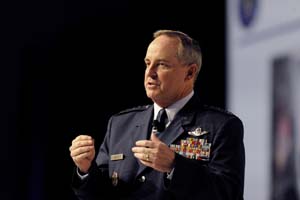
| ||
|
Gen. Mark Welsh III, Air Force Chief of Staff, said the hostility the current budget request generated in Congress is untenable. (USAF photo by Scott M. Ash) |
More likely, though, the solution is more complicated. The Air Force is going to have to offer up more realistic plans, acknowledge differing views, and present all the facts at one time, said retired Gen. Bruce Carlson, former Air Force Materiel Command commander and former National Reconnaissance Office director.
Carlson said he had luck turning around the NRO’s broken relationship with Congress by presenting lawmakers “a single … go-to guy” having all the facts on the agency readily available. The NRO—like the Air Force—had earned a devious reputation by sending plans to the Hill that simply couldn’t be executed.
During the same panel discussion, retired Gen. Gregory S. Martin, former commander of US Air Forces in Europe and Air Force Materiel Command, echoed Carlson’s comments, saying it’s “critical we represent ourselves properly” and be mindful of how the Air Force is perceived—even if it is “not a pleasant conversation.”
The F-35 Joint Strike Fighter Program is perhaps the best example of how pie-in-the-sky planning and tainted relationships can affect the mission.
Maj. Gen. Christopher C. Bogdan, the F-35 deputy program executive officer, caused a few dropped jaws on the expo floor when he boldly stated that the relationship between F-35 manufacturer Lockheed Martin, the Joint Program Office, and F-35 stakeholders—the Air Force, Navy, and the Defense Department more broadly—was “the worst I’ve seen. The worst I have ever seen.”
The F-35 is projected to be the most expensive acquisition program in DOD history and one of the most important. Though the Air Force, Navy, and Marine Corps maintain it is vital for future operations, the F-35 has been plagued with a series of highly publicized cost overruns and lengthy delays.
Bogdan said he now sees “some glimmer of hope” for the program, but he also acknowledged there is no chance of success if the relationship between government and industry remains strained. That’s “a cultural thing” that Lockheed Martin, the JPO, and DOD all need to work on, he said.
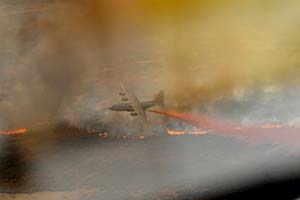
| ||
|
A MAFFS-equipped C-130 drops fire retardant on a West Texas fire. USAF is looking to communicate effectively all of what it does in support of the nation as well as the other services. (USAF photo by SSgt. Eric Harris) |
“It should not take 10, 11, or 12 months to negotiate a contract with someone we’ve been doing business with for 11 years,” blasted Bogdan. “There’s something fundamentally wrong with that. We’ve got to fix it. … I would tell you that I think that’s the biggest threat to this program.”
The Air Force’s proposed force structure cuts will be another major test of an already fragile relationship with Congress as service leaders, lawmakers, and the Council of Governors work to “fine tune” the plan submitted in the President’s Fiscal 2013 budget request, said Donley.
The Air Force wanted to cut 5,100 Air National Guard positions, 900 Reservists, and 3,900 Active Duty billets from its payroll next fiscal year, in an effort to help DOD reach the $487 billion in defense cuts over the next decade as mandated in the 2011 Budget Control Act. Air Force leaders said further cuts to the Active force were not possible without hurting readiness.
Much Work Left To Do
Congress didn’t buy that argument, though, saying the Air Force failed to present any evidence to back up its claim. The National Guard and the Council of Governors got into the debate, saying the reserve component provides a better bang for the Air Force’s buck and arguing that the cuts were unfair.
It is not clear what the final numbers will be, or how the debate will play out, but the Air Force has a lot of work to do if it wants to repair these relationships and present a unified message by the time the 2014 budget request rolls out this winter.
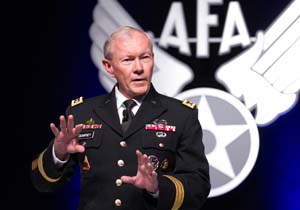
| ||
|
Chairman of the Joint Chiefs of Staff Gen. Martin Dempsey told the AFA conference attendees that USAF has perfected the art of joint operations. (DOD photo by Glenn Fawcett) |
At the conference, Welsh called the current budget request and the hostility it generated in Congress “just untenable.” However, in what appeared to be a competing opinion, Donley said the Air Force would “stand firm on our strategic decisions.” Both said they were committed to working with all parties to reach an agreement.
Donley said it is understandable that Congress would find USAF’s proposal a bit jarring, seeing as it was “the first time lawmakers saw” the depth of changes necessary to meet the required reductions. He stood by the Air Force’s decision to accept quality in exchange for size, however, and put “readiness above all.” Donley also emphasized the importance of moving “forward together as one Air Force.”
That solidarity was on display as Air National Guard Director Lt. Gen. Harry M. Wyatt III gave his conference address. Speaking to a packed room that included Welsh, Donley, and CMSAF James A. Roy among attendees, Wyatt acknowledged a difference of opinion between the reserve component and active force but said there is no deep-seated conflict.
Wyatt did note, however, that much of the distress could have been avoided if the governors and other parties were included or kept informed of the deliberation process.
DOD is holding discussions with the Council of Governors about how to keep the states in the budget discussion loop, said Donley. That’s a big step forward, considering budgeting deliberations typically don’t leave the Pentagon until they officially appear in the President’s budget request.
“We do not share that information [about how specific cuts are determined] down to every base, every fort, [or] post in the Department of Defense,” said Donley. However, he said, “we have to figure out how to build that bridge” between the Guard Bureau and the state adjutants general to share information “at the appropriate time.”
Wyatt also suggested the National Guard use its clout as the newest participant on the Joint Chiefs of Staff to help build a better Total Force, “not block it.” He said some of the tension between the Air Reserve Components and the Active component stemmed from lingering bad blood from last year’s fight over whether the Guard Bureau should get a seat on the Joint Chiefs.
“It’s time to recognize the Guard will be a full member of the Joint Chiefs,” Wyatt told reporters after his speech. The Air Force needs to understand the strength it has in this relationship when it comes to assembling budgets and priorities in the future.
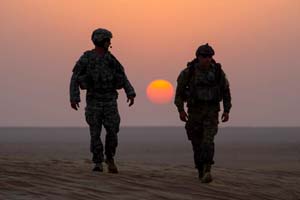
| ||
|
A1C Matthew Perry (r), a radio operator maintainer and driver, and Army Sgt. 1st Class Darryl Honick, a joint fire observer, support a mission in Southwest Asia. Today’s airmen are experienced in joint operations. (USAF photo by SSgt. Jonathan Snyder) |
Wyatt, who will be retiring in January 2013, said his office has worked hard to maintain credibility with the adjutants general and USAF leadership and to present ANG views even when they are not adopted. Rather than seeing a Guard Bureau chief on the JCS as a hindrance, Pentagon officials should embrace the new construct rather than try to refight a settled battle, he said.
Considering the emerging national security and fiscal environment, change is inevitable. Wyatt said the adjutants general are aware of that; they just want to get a “little bit of stability” rather than the tumult and mission changes experienced by the Guard since the 2005 Base Realignment and Closure plan was implemented.
With stabilization, the Active-ARC relationship will be “a whole lot better than it has been.”
Because force structure is just one of many tough decisions to come, communication will continue to top the Air Force’s priority list. It likely will become a regular talking point for senior leaders.
“We’ve got to think of a smarter way, a more innovative way, of communicating. We’ve got to figure out who our key partners are—on the Hill, in the Pentagon, in the Guard and Reserve—and we’ve got to make sure we’re connected to them in a meaningful way,” said Welsh. “We have to make it lasting. We can’t do it for a week and quit. This is a generational change.”
|
Shaping the Future Force The composition of the US Air Force will change in the coming years, not only in its force structure but also in its personnel footprint, senior leaders repeatedly stressed at AFA’s Air & Space Conference in September. The future Air Force will be a smaller, more adaptable, and deployable force transitioning from a war footing to a peacetime service. Airmen today must be better educated, more coalition-minded, and understand that the service is facing pressures to manage its growing personnel bills in the coming years. The Air Force that fought the Cold War once numbered more than a half-million airmen. It is now closing in on an end strength of 332,000. Fewer bodies means less overhead, but also less flexibility when it comes to staffing in areas such as squadron support functions. “We are a force that spends a lot of time doing the mission of the Air Force out there,” said Lt. Gen. Darrell D. Jones, head of manpower, personnel, and services on the Air Staff. “And you know, we pay a lot for this force.” Over the past two decades, the Air Force has reduced manpower some 38 percent—but at the same time, the price of the force has gone up 23 percent. Not per-airman—overall. “If you were the accountant in your family and you cut something by [38] percent, while the price went up 23 percent, somebody would be asking to look at your books,” Jones said. Before Desert Storm, the approximate pay gap between the Active Duty and the civilian sector was around 15 percent, Jones pointed out. “We’ve been very blessed, during the last 20 years … that that gap has closed. And so the price of our force is going up, and that’s something that we have to deal with.” While not as attention-grabbing as major recapitalization programs, personnel costs in the Air Force budget—from pay, to benefits, to child care, and to morale and recreation programs—make up almost 29 percent of the budget. As the service looks to pare down its overhead and decide where to separate and where to keep personnel, it is being careful to preserve “seed corn”—and avoid creating career bathtubs where certain fields are hollowed out of experience for extended periods. “We have taken a policy, we’ve taken a strategy … to protect the force today and in the future,” Jones said. He pointed out that today’s force is young—74 percent of airmen are under 34 years old. It is a tech savvy force and as such, it has different quality of life preferences and priorities and responds to different incentives than the Cold War generation. The Air Force has to find a way to keep up with what a younger force believes is important for quality of life and services. Jones said after surveys across the force, the Air Staff is going to focus on “core” areas of programs for airmen and their families—such as fitness facilities, child care, youth programs, and libraries. “We are going to be challenged to fund 100 percent of the core,” Jones cautioned. Retention is at a 17-year high, so to strike the right balance the Air Force has to involuntarily separate some airmen. “To protect the seed corn, you’ve got to make people get out,” Jones said bluntly, and over the next few years the service will be tinkering with its approaches to get people to separate, starting with voluntary separation, then using incentives, and only lastly involuntary separation initiatives. “We’ve gotten pretty scientific these days,” he said—noting airmen can go down to their group and Air Force Specialty Codes to find out exactly what’s available for options and incentives. “All the services are in lockstep because, frankly, whatever we offer to an airman needs to be offered to a soldier, a sailor, a marine, and a coastie because we have to do this together,” Jones added. As billets have come down, USAF has consolidated support staffing and functions at field operating agencies and will continue to do so. At the same time that overall end strength is going down, the Air Force is expanding in growing missions such as cyber operations and remotely piloted aircraft. As the force shrinks, both Jones and USAF’s top enlisted airman, CMSAF James A. Roy, believe education of the force must be protected—as demands on today’s airmen are far different than they were a generation ago. Jones noted when he entered the Air Force in 1979, 24 percent of all the enlisted force in the Air Force had attained some education beyond high school. Today that number is 96 percent. The success of the Community College of the Air Force has a great deal to do with this, he said, but educational opportunities are key to a versatile, adaptable force, and while tuition assistance programs will face pressure in the coming years, the service needs to be careful to protect its investment in its personnel development. Roy stressed development of the NCO corps in his speech at the conference, noting today’s airman is a joint and international airman. Roy has pressed to expand international NCO training and exchanges with partner nations such as Canada and Singapore—and announced at the conference that a new partnership exchange would soon open its doors in South Africa. “It’s taken a long time … but [the expansion is] very important because if you look at the deliberate development of airmen today, this is what it’s going to take—it’s going to take somebody with a joint background,” Roy said. “Somebody that understands this coalition much better than most of us did when we grew up.” He also announced a new position in the Air Force Secretariat’s international affairs shop, where SMSgt. Manny Pineiro will be the first NCO to work enlisted issues at that level, building partnership for events, exercises, and training with NCOs. Roy said the force today is well-prepared for the changes coming. “There’s a lot of bumps to come, for sure, but we are going to be OK,” he said. “We train you and educate you for a reason. … We want you to think your way through this.” —Marc V. Schanz |
